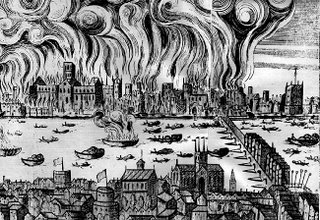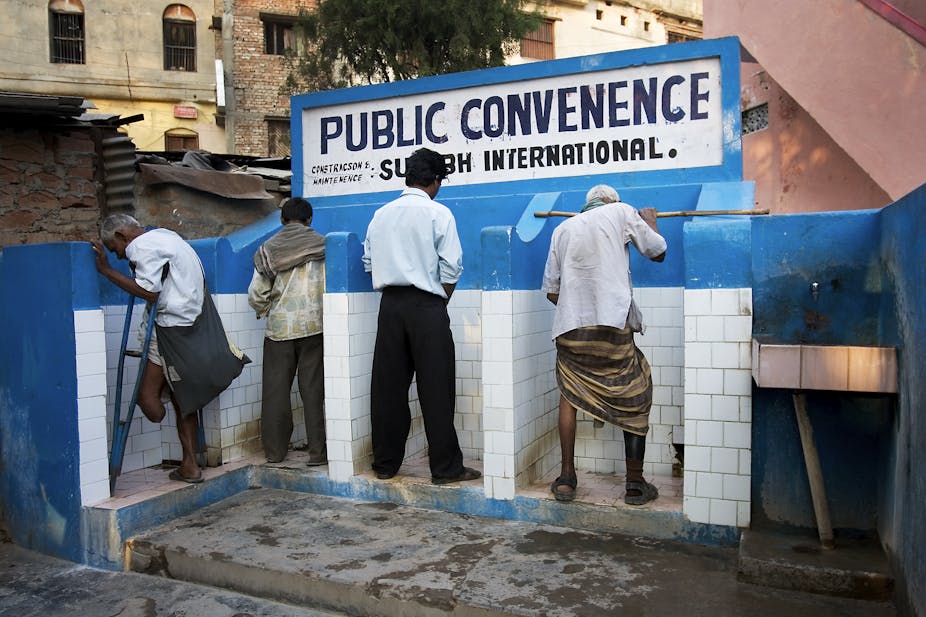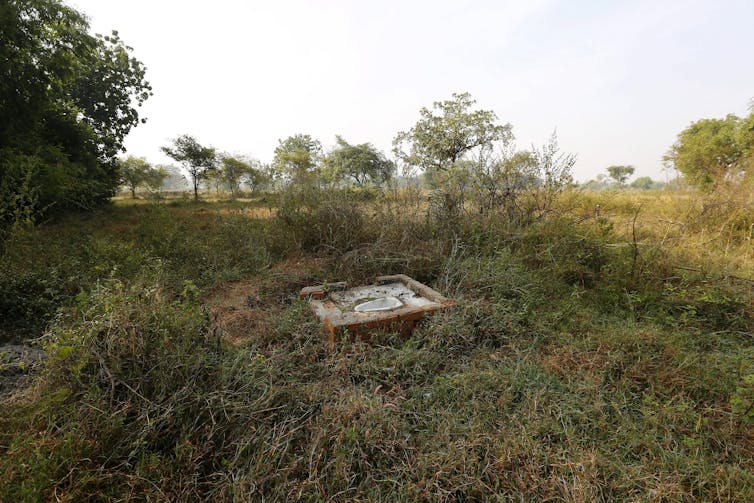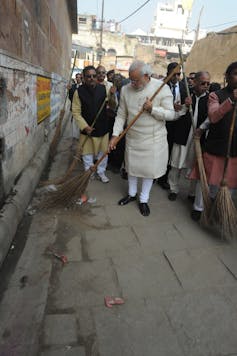The Great Fire of London occurred September 2, 1666, it was the 9/11 of its day. It's impact was not unlike that of 9/11.
Who had done the dastardly deed? Why had it occcured? Speculation and conspiracy theories abounded. Just as have followed in the wake of 9/11.
Great disasters change the social psyche forever. They are not only objective historic events but history impeding into the subjective life of a mass of people.

The Great Fire of London was the biggest single calamity in the history of the city. It had destroyed 13,200 houses, 87 parish churches, 6 chapels, 44 Company Halls, the Royal Exchange, the Custom House, St Paul's Cathedral, the Guildhall, the Bridewell and other City prisons, the Session House, four bridges across the Thames and Fleet rivers, three city gates and made homeless 100,000 people, one sixth of the inhabitants.
Within days the angry citizens wanted someone to blame for the destruction - the Dutch, perhaps, with whom England was at war? Catholic agitators or someone else? Before the authorities settled for a scapegoat in the person of a 26 year old French silversmith, Robert Hubert, who was executed at Tyburn for setting London ablaze, numerous suspects were brought before a special Committee.
There had been a lot of prophecies of the destruction of London by fire. Samuel Pepys, in his diary, noted that Prince Rupert, when told of the fire, recalled Mother Shipton's prophecy of 1641. Nostradamus was also believed to have written about the event.
But some recalled the trial of Colonel John Rathone in April of the same year. Rathbone and a group of former Parliamentarian officers had been arrested and tried for conspiring to overthrow the King and Government and restore the Commonwealth. The London Gazette, reporting the trial, revealed that the plan involved setting fire to London on September 3. The date had been selected by the conspirators as auspicious when they consulted the almanac of William Lilly for that year. It was claimed that this was a horoscope which was interpreted to show the fall of the monarchy. It was also a date close to the hearts of the English republicans, being the anniversaries of two of Cromwell's victories at Dunbar and Worcester. Rathbone and eight fellow officers were found guilty and executed.
Now people recalled the plot, the date, and William Lilly's horoscope. Suspicion fell on him. Had he been involved in the fire simply in order to enhance his reputation as an astrologer? Lilly needed little enhancement to his reputation. This was an age when astrology was a respected science and Lilly was a man of substance and political influence. His portrait was the most widely circulated, through his almanacs, in England, after the picture of Charles himself.
England was in the transition from fuedalism to becoming a parliamentary state ruling over the advent of capitalism. The fire as an alchemical metaphor gave birth to capitalism, phoneix like out of the ashes of the Great City. It was a purification, as 1665 was the year of the Great Plague, the fire destroyed the disease that swept through the Great City.

It was also the years of the Anglo Dutch wars, the first genuine capitalist war all previous wars had been religious ones or those for national territory for Princes, this was a war of the marketplace. Holland had just given birth to the first bourse; the stock exchange, changing forever the economic base of Europe.
The Dutch started joint stock companies, which let shareholders invest in business ventures and get a share of their profits - or losses. In 1602,Dutch East India Company issued the first shares on the the Amsterdam Stock Exchange. It was the first company to issue stocks and bonds.
As sea based merchants with mercenary armies the Dutch and English were in competition for the same colonies.
While in previous ages it was Venice and the Italian mercantilist provinces that dominated trade, by the time of the end of the 80 years war, and the rise of protestantism Holland, Amsterdam in particular became the worlds sea power and the home of capital. It was the first capitalist state. Before the destruction of London which would replace it as the centre of capital and capitalism, within the reconstructed City of London, today known as the financial centre of English capitalism or simply as 'The City'.
Like Venice, the Netherlands was a maritime power. By the 1550s the Dutch merchant marine was the largest in Europe, operating from the Azores to the Baltic to the Levant. The Amsterdam carrying trade increased ten-fold
from 1537 to 1547. In 1550, on any given day, there were 2500 ships in the river Scheldt, off Antwerp, with 500 new ships arriving each day.
A major catalyst for the emergence of Amsterdam as the financial capital was the 1585 capture of Antwerp by the Duke of Parma's army. This engendered the "great exodus" from the southern provinces, where the Calvinists were most numerous. Over 150,000 fled, and both Antwerp and Ghent lost more than half of their populations.
More than 19,000 merchants, including many key bankers and Bourse speculators left Antwerp, with most settling in Amsterdam.
After 1588 Dutch financial and commercial expansion exploded:
1588 - 2,000 Dutch merchant vessels.
1588 - Anglo-Dutch defeat of Spanish Armada
1590-1600 - massive expansion of Dutch seaborne trade
1594 - founding of Dutch "Long Distance Company" (Company of the Far Countries). Beginning of serious trade
with east. First voyage of 4 ships to Asia sent out in 1595
1598 - first marine insurance; Dutch dominated insurance markets into the 18th century
1600 - first Dutch ship reaches Japan
1600-1620 - flourishing Dutch Levant trade.
1600-1635 - undeclared war with Portugal
1601 - chartering of the East India Company (the VOC - Verenigde Oostindische Compagnie), dominated by
Amsterdam. Oldenbarneveldt said: "The great East India Company, with 4 years of hard work public and private, I
have helped establish, in order to inflict damage on the Spanish and Portuguese."
1605 - first Dutch colony in Indonesia, following defeat of Portugal at Molucca
1606 - first Dutch slave ships.
1606 - control over coinage & monetary affairs shifts from provinces to States General "Mint Chamber"
1607 - Dutch destroy a Spanish fleet off Gibraltar
1608 - Opening of the New Bourse building in Amsterdam
1609 - Bank of Amsterdam founded
1609 - Treaty of Antwerp. 12 year truce with Spain, negotiated by Oldenbarnevelt. Venice the first government
to recognize Dutch independence. Oldenbarnevelt's son Van der Myle becomes Ambassador to Venice, at the
request of the Venetian Ambassador in Paris, Antonio Foscarini.
1610-1612 - first Dutch colonies in Brazil
1618 - Venice signs defensive alliance with Netherlands against Hapsburgs
1619 - Founding of Batavia, capital of the Dutch East Indies
1621 - Extermination of the natives of the island of Band by the VOC. Gov-Gen. Jan Pieterszoon gave orders to
kill the entire native population because they refused to give the Dutch a nutmeg monopoly. Slaves brought in to
work Dutch plantations.
1621 - founding of Dutch West Indies Company
-26-
1621-1648 - Continual (primarily naval) war with Spain and Portugal
1624 - founding of New Amsterdam
1625 - Establishment of the Levantine Trading Company
1630 - almost all of the wealthier classes involved in the East India trade, or finance, or both.
The Bank, the Bourse, and the Financial Markets
The New Bourse (exchange) building opened in Amsterdam in 1608, and the Bank of Amsterdam (Wisselbank) was founded the following year in 1609. The Wisselbank was a public bank, modeled on Venice's Banco della Piazza di Rialto. It had a monopoly on all exchange of species, and trade in precious metals. It was a clearinghouse for bills of exchange, but it was NOT a commercial lending bank, except for loans to the government and the VOC.
More advanced usage of bills of exchange than earlier in Venice and Antwerp. Even before independence, the Dutch provinces created a permanent debt market (world's first "consolidated public debt") to finance the war, and in Antwerp, bankers perfected a continuing market in negotiable international bills of exchange. The trading in financial securities, which took place at the Bourse, created the first modern stock exchange, and
by the mid-1600s, the Amsterdam Bourse was described as the "place where the whole world trades." During the 17th century there was a famous boast about the Amsterdam Bourse which was printed on plaques, posters, and medallions:
Ephesus fame was her temple
Tyre her market and port
Babylon her masonry walls
Memphis her pyramids
Rome her empire
All the world praises me
The new bank - the Wisselbank - was "public" in the sense that, like the Venetian creations of the Giovani, and the later Bank of England, it was entirely privately owned but completely merged with the oligarchical institutions of the state. As such, it assumed sovereign powers to the point that it dictated financial policies, and those policies became the Nation's policies. This paradigm was later to be greatly fine-tuned in England. The Bank's directors had ,offices in City hall, and its money was kept in the city vault. It was politically backed by the city's fathers. The security of its holdings established the new "bank money" as the center of the city's securities trading. This, combined with the international trade in hard currency (specie), in which the bank played a major role, made Amsterdam the world's largest international securities market (including VOC company paper and municipal bonds). The most popular of the securities investments was the national debt. If you look at the scope of what was created between 1594 and 1621, in terms of the institutions, the accumulation of capital, and the centralized way that capital could be deployed, this was all obviously Venetian;
but in some ways it went further, in the sheer size and power of the financial/political capabilities involved. One of the Bourse speculators of the time, a Sephardic Jew named Jossef de la Vega, authored a work describing in detail how the Dutch markets could be used to mobilize capital in ways not previously done. This book was translated into English by John Houghton and used by William III's English advisors in financing his wars against Louis XIV.
The advent of bourgoise power, culture and economics was to arise from the ashes as Ashmole and other Grand Architects, rebuilt the city and in the process created Freemasonry and the English Englightenment.
 With the great fire of London, in 1666, there came a renewed interest in Masonry, many who had abandoned it flocking to the capital to rebuild the city and especially the Cathedral of St. Paul. Old Lodges were revived, new ones were formed, and an effort was made to renew the old annual, or quarterly, Assemblies, while at the same time Accepted Masons increased both in numbers and in zeal.
With the great fire of London, in 1666, there came a renewed interest in Masonry, many who had abandoned it flocking to the capital to rebuild the city and especially the Cathedral of St. Paul. Old Lodges were revived, new ones were formed, and an effort was made to renew the old annual, or quarterly, Assemblies, while at the same time Accepted Masons increased both in numbers and in zeal.
The History of Masonry in England from the Fire of London to the Accession of George I.
The year 1666 afforded a singular and awful occasion for the utmost exertion of masonic abilities. The city of London, which had been visited in the preceding year by the plague, to whole ravages, it is computed, above 100,000 of its inhabitants fell a sacrifice[28], had scarcely recovered from the alarm of that dreadful contagion, when a general conflagration reduced the greatest part of the city within the walls to ashes, This dreadful fire broke out on the 2d of September, at the house of a baker in Pudding-lane, a wooden building, pitched on the outside, as were also all the rest of the houses in that narrow lane. The house being filled with faggots and brush-wood, soon added to the rapidity of the flames, which raged with such fury, as to spread four ways at once.
Jonas Moore and Ralph Gatrix, who were appointed surveyors on this occasion to examine the ruins, reported, that the fire over-ran 373 acres within the walls, and burnt 13,000 houses, 89 parish churches, besides chapels, leaving only 11 parishes standing. The Royal Exchange, Custom-house, Guildhall, Blackwell-hall, St. Paul's cathedral, Bridewell, the two compters, fifty-two city companies halls, and three city gates, were all demolished. The damage was computed at 10,000,000 l. sterling[29].
After so sudden and extensive a calamity, it became necessary to adopt some regulations to guard against any such catastrophe in future. It was therefore determined, that in all the new buildings to be erected, stone and brick should be substituted in the room of timber. The King and the Grand Master immediately ordered deputy Wren to draw up the plan of a new city, with broad and regular streets. Dr. Christopher Wren was appointed surveyor general and principle architect for rebuilding the city, the cathedral of St. Paul, and all the parochial churches enacted by parliament, in lieu of those that were destroyed, with other public structures. This gentleman, conceiving the charge too important for a single person, selected Mr. Robert Hook, professor of geometry in Gresham college, to assist him; who was immediately employed in measuring, adjusting, and setting out the grounds of the private streets to the several proprietors. Dr. Wren's model and plan were laid before the king and the house of commons, and the practicability of the whole scheme, without the infringement of property, clearly demonstrated: it unfortunately happened, however, that the greater part of the citizens were absolutely averse to alter their old possessions, and to recede from building their houses again on the old foundations . Many were unwilling to give up their properties into the hands of public trustees, till they should receive an equivalent of more advantage; while others expressed distrust. Every means were tried to convince the citizens, that by removing all the church-yards, gardens &c. to the out-skirts of the city, sufficient room would be given to augment the streets, and properly to dispose of the churches, halls, and other public buildings, to the perfect satisfaction of every proprietor; but the representation of all these improvements had no weight. The citizens chose to have their old city again, under all its disadvantages, rather than a new one, the principles of which they were unwilling to understand, and considered as innovations. Thus an opportunity was lost, of making the new city the most magnificent, as well as the most commodious for health and trade, of any in Europe. The architect, cramped in the execution of his plan, was obliged to abridge his scheme, and exert his utmost labour, skill, and ingenuity, to model the city in the manner in which it has since appeared.
Freemasonry was unique amongst club culture of London, and it overlapped with the existing shift in the guilds from being producer cooperatives to becoming self sustaining corporations. Fremasonry was declasse, and was the source of the scientific revolution of the 17th Century.
Since the occult sciences held hold, astrology, alchemy, etc. ideologically the tapestry of the York Rite and its mystery's, became the central key to the mythology of Freemasonry. Its reality was that in rebuilding the Great City the Scottish artificers who held the York Charter (which is actually a banner) , and the rites of their guild, were raised to an exaulted level as a source for the rites and roots of Freemasonry. It was Ashmole and Company who refashioned London as the World, physically as well as culturally, scientifically and economically.
With the rise of non-operative Freemasonry, scientific discoveries were held in high esteem, as the Lodges functioned as the natural laboritories of discourse between literate tradesmen and aristocratic scientists, members of the Royal Society. Such interactions were frowned upon in proper society, and indeed made Freemasonry unique amongst the English clubs, which were more like gangs, identified with a particular area of the city, trade, or class.
The end of the Catholic power saw the Guilds under their charters move from being co-frateranl orders, to becoming the economic power of Europe and in particular England. The power of the Guilds was shown in the Great Easter Pagents, the York Mystery plays, which were self financed by the surplus profits earned by each guild.
By Ashmole's time the Guilds operative had become something else, they had become shared stock companies of mastercraftsmen. Journeymen and apprenctices were restricted to roles as servants of the master. The master held the tools and the rules and thus shared in the profits while his workers did not.
It is at this historic moment that non-operative freemasonry takes over from the operating guilds of old. The traditions of operative masonry and the guilds related to it now were transformed into either stock companies, or else the beginings of journeymens trades unions.
The Earliest Masonic Document
The language of this Act is sufficiently conclusive, but for accumulation of proofs, I shall proceed to establish the same position by giving a summary of the oldest, and only genuine document extant on the subject of Masonry. This document is a MS. Bib. Reg. 17. A. I. ff. 32, written in a hand that cannot be later than the close of the 13th century, and of which a copy has been published by J. O. Halliwell. It commences with a history of Architecture from the beginning, and of the introduction of the art into England, and then proceeds to give, in rhyme, the Rules of the Craft, conceived in precisely the same business-like spirit as those of a Trades-Union. The preamble is: "Hic incipiunt Constitutiones Artis Geometricae secundum Euclydem."
No Relation of Modern Masons to Mediæval Guilds All this evidence goes to show that our Freemasons have no relationship, either actual or traditional, with the mediæval guilds bearing the same appellation, a pretence they so zealously maintain. The latter were corporations of real workmen, in which each person, after serving a regular apprenticeship, and, according to the custom still kept up in some counties, producing a trial-piece to prove his competency, was admitted "free" of the Guild, and "accepted" amongst the members of the same. The compotations accompanying the ceremony are in truth the sole point of resemblance between the ancient and the modern Freemasons.
The mediæval guild of Masons, as we have seen, was no more a secret society than were the guilds of Carpenters, Cordwainers or Tailors. Every man indeed belonging to the first-named (and this is the only thing belonging to the Craft, that really carries with it an air of mysterious antiquity) had, upon admission, a mark (or cypher) assigned him, which he was bound to put upon every stone he dressed (a rule still observed) in order to distinguish his work from that of his fellows, against the time when the materials should be examined by the master-mason, who paid him for those approved, but stopped his wages for those spoiled through his fault. Similarly every "Merchant of the Staple" joined with his initials upon his seal, or trade mark, the mark of the staple-town to which he belonged. This latter, thoug much alike in outline, was variously modified so as to indicate each of the fifteen towns in England, Ireland, and Wales, appointed by Edward III. In all mediæval documents relating to building, the name "Freemason" signifies merely the worker in hewn stone, the inferior workman who ran up the body of the wall in rubble or ragstone being called the "Rough-waller." Lastly, a very puzzling question presents itself--if our Freemasons be the legitimate successors in an unbroken line of the ancient lodges and guilds, how came it that all the principles of Gothic architecture were utterly lost within less than a century?
When and where was speculative Masonry “born”? Someone must have been the first Freemason, who was it?
There was activity in English lodges as well. In 1600, the word “Freemason” was used in the
York Roll. In the early 1620’s the term ‘Accepted’ was used to describe some members in the
Account Book of the London Mason's Company. Accounts of another London guild, the Worshipful
Company of Freemasons differentiate between "accepted" and "operative" members.
In his copious diary, Sir Elias Ashmole notes:
1646 Oct. 4H.30pm I was made a Free-Mason at Warrington in Lancashire with Coll. Henry
Mainwaring of Karincham in Cheshire. The names of those that were of the Lodge, Mr Rich:
Penkett Warden. Mr James Collier, Mr Rich Sanchey, Henry Littler, John Ellam, Rich: Ellam,
Hugh Brewer.
It has been determined by scholars that almost all present at this initiation were not operative
stonemasons, (the profession of Rich Ellam or Ellom is not known, however he described
himself a “Freemason” in his will) and thus of the new order of Freemasons. It is very
interesting to note that Colonel Mainwaring was a well known Parliamentarian or
“roundhead”, and that the 29 year old Ashmole was the Royalist Comptroller of Ordnance.
The Great Scientific Englightenment, the English Englightenment; to differentiate it from the humanistic englightenment of the Italian Rennisance two hundred years earlier, was the result of the reconstruction of the World after the Great Fire.
That world was London, and the birthing of British Capitalism. The scientific age began with the rebuilding of London. The impact of science cannot be underestimated as the shift in conciousness after the Great Fire, which had followed the Great Plague and the Cromwellian Revolt and the Great Revolution, led to a protestantism that was open to interpeting the world in a humanistic fashion. One that would give a moral logic for the establishment of capitalism.
The later Industrial Revolution that was so crucial for the creation of modern capitalism, was to be formed at this time as science moved from being simply an understanding of God in the world, to the understanding of Gods Laws. Nature now took the place of God and man the scientist replaced Gods priests, in interpetating the world.
It is within Freemasonry we find the modern Englightenment ideals of Liberty and utilitarianism, as well as the link between the right to private property and individualism.
In fact, to the masons of 18th century Britain, the word ‘liberty’ was understood not in this primitive sense, but precisely in the interpretation given it by the philosopher John Locke in his Two Treatises of Government of 1690.
Locke has been claimed as a Freemason on the basis of a letter of his dated 1696. This is now considered weak evidence, but the important point is that all pious masons of the time firmly believed Locke had been initiated into the Order. He had indeed been made a Fellow of the Royal Society, a hotbed of Freemasonry, in 1668, and his particular friends there were Robert Boyle, a known Freemason, and Isaac Newton, a member of a quasi-masonic society. Freemasonry in the 18th century has sometimes been described as Rousseauian, but first and foremost, it could also be, and was, right into the late 1760s Lockean, as well as essentially republican.
The Two Treatises of Government was the fruit of years of reflection upon the true principles in politics, a reflection resting on Locke’s own observations. Government, Locke held, is a trust; its purpose is the security of the citizen’s person and property; and the subject has the right to withdraw his confidence in the ruler when the latter fails in his task. Government and political power are necessary, but so is the liberty of the citizen; and in a democratic, constitutional monarchy, a type of government is possible in which the people are still free.
Locke wrote that we cannot be obliged to a government to which we have not given some sign of consent (Book II, §.119), and that ‘the end of Law is to preserve and enlarge freedom’ (II, 57). Governments are dissolved when the ‘Legislative, or the Prince, either of them act contrary to their trust’ (II, 221), and ‘Power reverts to the people’, who may then establish a new legislative and executive (II, 222). It is the people who decide when a breach of trust has occurred, for only the man who deputes power can tell when it is abused (II, 240). In the case of dispute ‘the final appeal is to God’, by which Locke specifically meant revolution.
Liberty is the antithesis of tyranny, for ‘As Usurpation is the exercise of Power, which another hath a Right to; so Tyranny is the exercise of Power beyond Right, which no Body can have a Right to. And this is making use of the Power any one has in his hands; not for the good of those, who are under it, but for his own private separate Advantage.’ (II, 199). ‘When any one, or more, shall take upon them to make Laws, whom the People have not appointed so to do, they make Laws without Authority, which the people are not therefore bound to obey; . . .’ (II, 212).
‘The end of Government is the good of Mankind, and which is best for Mankind, that the People should be always expos’d to the boundless will of Tyranny, or that the Rulers should be sometimes liable to be oppos’d, when they grow exorbitant in the use of their Power, and imploy it for the destruction, and not the preservation of the Properties of their People?’ (II, 229). In such a situation, revolution is justified, for ‘When a King has Dethron’d himself, and put himself in a state of War with his People, what shall hinder them from prosecuting him who is no King, as they would any other Man, who has put himself into a state of War with them; . . .’ (II, 239).














